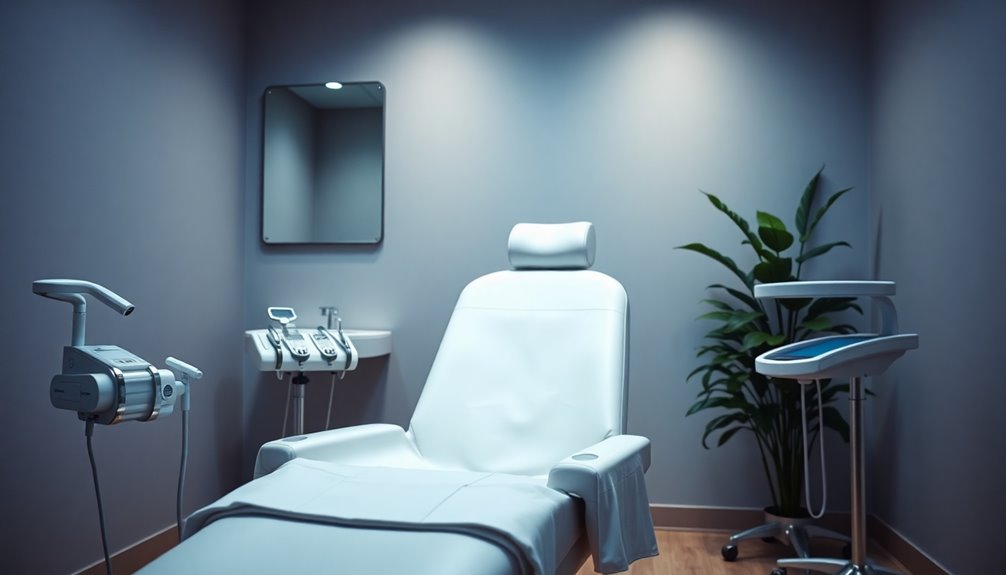A Lifestyle Lift is a minimally invasive cosmetic procedure that tightens sagging skin on your face through incisions near your ears. It typically takes 1.5 to 2 hours under local anesthesia, allowing for a quicker recovery. While it may present a less invasive option compared to traditional facelifts, there have been concerns about safety and inconsistent results. If you're curious about what to contemplate before undergoing this procedure, there's more important information ahead.
Key Takeaways
- A Lifestyle Lift is a minimally invasive facial rejuvenation procedure that tightens sagging skin through incisions around the ear.
- The procedure is typically performed under local anesthesia, allowing for quicker recovery compared to traditional facelifts.
- It involves folding and suturing the SMAS layer for enhanced firmness and has a duration of about 1.5 to 2 hours.
- The technique has faced scrutiny due to safety concerns, including malpractice claims and a patient's death linked to the procedure.
- Lifestyle Lift results may vary, and consultation with a qualified plastic surgeon is essential to weigh risks and benefits.
Overview of Lifestyle Lift

If you're considering facial rejuvenation, the Lifestyle Lift might come up as an option. This minimally invasive procedure aims to tighten and eliminate sagging skin on your face through incisions made around the ear.
While marketed aggressively, the Lifestyle Lift has faced scrutiny due to safety issues and inconsistent results. It's important to know that the techniques used aren't exclusive to the Lifestyle Lift; any qualified plastic surgeon can replicate them without needing special training.
The procedure typically uses local anesthesia, and while it can offer results, many patients report dissatisfaction and permanent scarring.
Always consult with a trusted plastic surgeon to understand the risks and benefits before making your decision.
Procedure Details

When considering a Lifestyle Lift, you'll find that the procedure focuses on tightening sagging skin through strategic incisions made around your ears.
Typically performed under local anesthesia, this mini-facelift aims to provide quicker recovery times compared to traditional facelifts.
During the procedure, an incision is made, and the surgeon folds and sutures the SMAS (superficial musculoaponeurotic system) in specific locations to enhance firmness.
The entire process lasts about 1.5 to 2 hours, during which excess skin is removed to achieve a more youthful appearance.
Afterward, the incisions are sutured closed, ensuring minimal visibility.
While many seek this option for its convenience, it's crucial to discuss potential risks and outcomes with your surgeon beforehand.
Claims and Controversies

Despite its appeal as a convenient option for facial rejuvenation, the Lifestyle Lift has faced significant scrutiny over the years. Many controversies have emerged surrounding this mini-facelift, raising concerns about its safety and effectiveness.
Here are some key issues:
- Multiple malpractice claims, including inadequate monitoring of essential signs during surgeries.
- A tragic incident in 2009 where a Florida woman died shortly after her Lifestyle Lift facelift.
- A $300,000 settlement in 2009 due to false customer endorsements posted by the company.
- An eight-part CBS mini-series in 2008 showcasing dissatisfied patients, damaging the brand's reputation.
These factors contributed to ongoing legal challenges and the eventual bankruptcy of the company in 2015, leaving many questioning the ethics of this plastic surgery option.
Malpractice and Safety Issues

While many seek the convenience of a Lifestyle Lift for facial rejuvenation, serious malpractice and safety concerns have surfaced.
Allegations of failure to monitor essential signs during procedures have been reported, raising questions about patient safety. In March 2010, a lawsuit linked the company to a patient's death due to anesthesia complications, highlighting the potential risks involved.
Complaints from a plastic surgeon in 2008 pointed to inadequate emergency services for patients undergoing the procedure.
Although Lifestyle Lift has denied negligence in various lawsuits and continues to support its board-certified surgeons, the scrutiny over surgical practices remains.
As you consider this option, it's important to weigh these risks against the benefits of the procedure.
Comparison With Traditional Facelift

Considering the safety concerns surrounding Lifestyle Lifts, it's important to examine how they stack up against traditional facelifts.
- Incisions Made: Traditional facelifts hide incisions behind the hairline, while Lifestyle Lift patients often have visible scars due to incisions in front and back of the ear.
- Anesthesia: Traditional facelifts typically require general or local anesthesia; Lifestyle Lifts are usually performed under local anesthesia, which can lead to rushed procedures.
- Results: Traditional facelifts provide longer-lasting, natural-looking results, whereas many Lifestyle Lift patients report dissatisfaction with their outcomes.
- Customization: Skilled surgeons tailor traditional facelift techniques to individual facial features, unlike the more standardized approach in Lifestyle Lifts.
These factors highlight significant differences that could impact your decision-making process.
Qualifications for the Procedure

When it comes to undergoing a Lifestyle Lift, having the right qualifications is vital for ensuring a safe and effective procedure.
Any qualified plastic surgeon can perform this lift, as it doesn't require special training beyond standard facelift qualifications. Although it's marketed as unique, this procedure utilizes techniques familiar to many experienced practitioners.
It's essential that your surgeon has expertise in cosmetic surgery to guarantee ideal results and your satisfaction. To achieve the best outcome, always select a board-certified surgeon who can evaluate your individual needs and assess whether the Lifestyle Lift is appropriate for you.
This way, you can feel confident in the care you receive and the results you expect.
Making an Informed Decision

Choosing to undergo a Lifestyle Lift involves careful thought and research.
It's crucial to verify that this procedure aligns with your needs. Here are some key points to take into account:
- Consult a board-certified plastic surgeon to discuss your expectations and get personalized advice.
- Compare results between the Lifestyle Lift and traditional facelift, as the latter often yields more consistent outcomes.
- Be cautious of marketing claims, which may be misleading due to past legal issues surrounding the Lifestyle Lift company.
- Seek information from reputable sources to make an informed decision and achieve your desired aesthetic results.
Frequently Asked Questions
What's the Difference Between a Facelift and a Lifestyle Lift?
When considering a facelift versus a Lifestyle Lift, you'll notice key differences in technique and results.
A facelift typically involves deeper tissue lifting, providing more thorough and longer-lasting results.
In contrast, a Lifestyle Lift focuses primarily on tightening the skin, often leading to less consistent outcomes.
You'll also find that recovery times vary, with traditional facelifts requiring more downtime due to their invasive nature compared to the quicker process associated with a Lifestyle Lift.
What Is the Average Cost of a Lifestyle Lift?
When considering a financial leap, think of it as investing in your future self.
The average cost of the procedure you're curious about ranges from $4,000 to $10,000. Prices can fluctuate based on your location and the surgeon's expertise.
Don't forget to account for extra expenses like anesthesia and post-operative care, which can add up.
Always explore financing options, but read the fine print to guarantee you're making a safe choice for your wallet.
How Long Does the Lifestyle Lift Last?
The results of a Lifestyle Lift typically last between 1 to 3 years.
Your skin type, age, and lifestyle play significant roles in how long you'll enjoy the effects.
Many people find that they experience some dissatisfaction, which might lead to wanting additional procedures sooner than expected.
To maintain your desired look, regular follow-up treatments are often recommended, as the results can diminish more quickly than with traditional facelifts.
What Is the 20 Minute Permanent Facelift?
The 20 Minute Permanent Facelift is a minimally invasive procedure that tightens sagging skin and rejuvenates your facial contours quickly.
It uses strategic suturing of the SMAS, giving you a natural look without the long recovery time of traditional facelifts.
Typically performed under local anesthesia, the procedure lasts about 20 minutes, resulting in minimal bruising and swelling.
If you're considering this option, consult a qualified plastic surgeon to see if you're a suitable candidate.
Conclusion
In choosing a Lifestyle Lift, you're not just opting for a procedure; you're investing in your self-image. While it might seem like a quick fix, remember that every choice carries weight. Consider the claims, controversies, and your unique qualifications. After all, isn't your confidence worth a little extra research? Weigh the pros and cons carefully, and don't rush; the best decisions come from informed choices that align with your personal goals and values.









